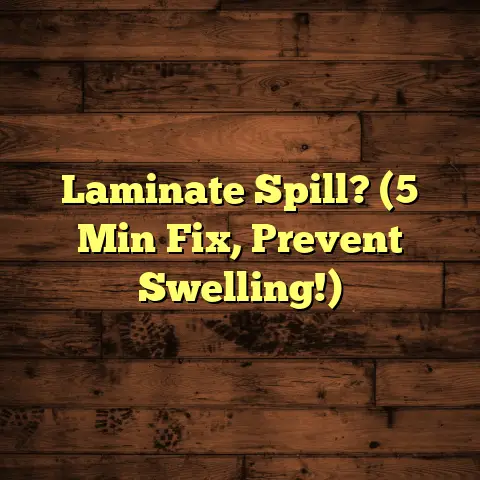Is Epoxy Floor Toxic? (1 Toxic Sign!)
I’m a flooring contractor, and I’ve seen it all.
From beautiful hardwood to questionable linoleum, I’ve spent years knee-deep in the world of floors.
And let me tell you, choosing the right flooring can be a real headache.
We all want something durable, something that looks great, and something that’s easy to clean.
That’s why epoxy flooring has become so popular.
It’s tough, it’s shiny, and it can handle almost anything you throw at it.
But here’s the thing: as epoxy floors have exploded in popularity, so have the questions about their safety.
The big one?
“Is epoxy floor toxic?”
That’s what we’re diving into today.
We’re going to explore the potential toxicity of epoxy flooring and, more importantly, we’re going to focus on ONE critical sign that you absolutely need to watch out for.
Trust me, this is important. Let’s get started!
Section 1: Understanding Epoxy Flooring
So, what exactly is epoxy flooring?
Think of it as a super-tough coating that goes over your existing concrete floor.
It’s made from two main components: epoxy resin and a hardener.
When these two are mixed together, a chemical reaction happens, creating a rigid, plastic-like material.
This material bonds tightly to the concrete underneath, forming a seamless, durable surface.
The application process usually involves preparing the concrete surface, mixing the resin and hardener according to the manufacturer’s instructions, and then applying the mixture in thin, even coats.
Depending on the type of epoxy and the desired look, multiple coats might be needed.
Now, you’ll find epoxy flooring in all sorts of places.
Garages are a classic example.
Its resistance to oil spills and tire marks makes it perfect for that environment.
But you’ll also see it in warehouses, factories, hospitals, commercial kitchens, and even retail spaces.
Basically, anywhere that needs a floor that can withstand a lot of wear and tear.
What makes epoxy so appealing?
Let’s break down some of the key advantages:
- Durability:
This is the big one.
Epoxy floors are incredibly tough and can handle heavy traffic, impacts, and even some pretty harsh chemicals. - Resistance to stains and chemicals: Oil, grease, acids – epoxy can stand up to a lot of abuse without staining or degrading.
- Attractiveness: Epoxy floors can be customized with different colors, patterns, and even decorative flakes to create a unique look.
- Easy to clean: A simple mop and some mild soap are usually all it takes to keep an epoxy floor looking its best.
- Long lifespan: With proper installation and maintenance, an epoxy floor can last for many years.
Over the years, epoxy flooring technology has come a long way.
We’ve seen improvements in the formulas, making them even more durable and resistant.
There are now self-leveling epoxies that make installation easier.
There are also water-based epoxies that are lower in VOCs (we’ll talk about that later).
The flooring industry is constantly evolving, and epoxy is definitely a big part of that.
In fact, the global epoxy resin market was valued at USD 12.74 billion in 2023 and is projected to grow to USD 17.76 billion by 2032 (Fortune Business Insights).
That’s a lot of epoxy!
Section 2: The Chemicals in Epoxy Flooring
Okay, let’s get a little more technical.
To really understand the potential toxicity of epoxy flooring, we need to talk about the chemicals involved.
As I mentioned earlier, epoxy flooring is made from a combination of epoxy resin and a hardener.
But what exactly are those?
Well, epoxy resins are a broad class of chemicals, but many are based on epichlorohydrin and bisphenol A (BPA).
These chemicals react together to form the strong, cross-linked polymer that gives epoxy its strength and durability.
Let’s break those down a little further:
- Epichlorohydrin:
This is a reactive compound used in the production
of many epoxy resins.
It’s known to be a potential irritant and has raised some health concerns at higher levels of exposure. - Bisphenol A (BPA):
You’ve probably heard of BPA before.
It’s a chemical used in the production of certain plastics and resins.
It’s been linked to a variety of health issues, including hormone disruption.
It’s important to note that BPA is typically reacted during the epoxy curing process, so the amount of free BPA in a fully cured epoxy floor should be minimal.
However, exposure can still occur during the installation phase, especially if proper safety precautions aren’t followed.
Now, there are regulatory standards and guidelines in place to control the use of these chemicals in flooring products.
For example, the EPA (Environmental Protection Agency) in the United States has regulations regarding the use and disposal of chemicals like epichlorohydrin.
Additionally, many manufacturers are now offering low-VOC or zero-VOC epoxy options, which contain fewer volatile organic compounds that can off-gas into the air.
Speaking of health effects, it’s important to be aware of the potential risks associated with exposure to these chemicals.
During installation, inhalation of epoxy fumes can cause respiratory irritation, headaches, and dizziness.
Skin contact can lead to dermatitis or allergic reactions.
Long-term exposure to high levels of these chemicals has been linked to more serious health problems, although the risk from a properly installed and cured epoxy floor is generally considered low.
A study published in the Journal of Occupational and Environmental Hygiene found that workers involved in epoxy resin manufacturing had a higher risk of respiratory problems and skin sensitization.
While this study focused on manufacturing, it highlights the potential health effects associated with exposure to these chemicals.
Section 3: Identifying Toxic Signs
Alright, let’s get to the heart of the matter: how do you know if your epoxy floor is potentially toxic?
This is where “toxic signs” come in.
These are warning signs that something might not be right with your epoxy floor, and they should prompt you to investigate further.
I want to focus on one specific toxic sign that I’ve seen time and time again in my years as a flooring contractor:
The presence of strong chemical odors during and after installation.
Let me be clear: a slight odor during installation is normal.
After all, you’re dealing with chemicals.
But if the odor is overpowering, persistent, and makes you feel sick or uncomfortable, that’s a major red flag.
Here’s why these odors are so concerning: they indicate off-gassing of volatile organic compounds (VOCs) from the flooring.
VOCs are chemicals that evaporate into the air at room temperature.
Many epoxy resins contain VOCs, and when the epoxy is curing, these VOCs are released into the surrounding environment.
The implications of strong odors, and therefore high VOC levels, are significant in terms of indoor air quality.
Poor indoor air quality can lead to a whole host of health problems, as we’ll discuss in the next section.
But for now, just remember this:
A strong, lingering chemical odor is a sign that your epoxy floor is releasing potentially harmful VOCs into the air.
Don’t ignore it!
What kind of odors are we talking about?
Well, it can vary depending on the specific chemicals in the epoxy, but common descriptions include:
- A strong, pungent smell similar to ammonia.
- A solvent-like odor that burns the nose and throat.
- A sickly sweet smell that is overpowering.
If you experience any of these odors, especially if they’re accompanied by symptoms like headaches, dizziness, or nausea, it’s time to take action.
Section 4: Health Risks Associated with Epoxy Flooring
Let’s delve deeper into the health risks associated with epoxy flooring, especially when those toxic signs, like strong chemical odors, are present.
As I mentioned before, poorly ventilated spaces are particularly problematic.
If VOCs can’t escape, they’ll build up in the air, increasing your exposure and the risk of health problems.
So, what kind of symptoms can arise from exposure to these toxic fumes?
Here are some of the most common:
- Headaches: Often described as throbbing or pressure-like.
- Dizziness: Feeling lightheaded or unsteady.
- Respiratory issues: Coughing, wheezing, shortness of breath, and irritation of the nose and throat.
- Skin irritation: Rashes, itching, and burning sensations.
- Eye irritation: Redness, watering, and blurred vision.
- Nausea: Feeling sick to your stomach.
- Fatigue: Feeling unusually tired or weak.
These symptoms can range from mild to severe, depending on the level of exposure and individual sensitivity.
Some people are simply more susceptible to the effects of VOCs than others.
What about the long-term effects of living or working in environments with epoxy flooring?
This is where things get a little more complicated.
While the immediate effects of VOC exposure are often temporary, chronic exposure can lead to more serious health problems.
Some studies have linked long-term VOC exposure to an increased risk of:
- Asthma: VOCs can trigger asthma attacks and worsen existing respiratory conditions.
- Allergies: VOCs can sensitize the immune system, making you more prone to allergies.
- Neurological problems: Some VOCs have been linked to memory problems, difficulty concentrating, and other neurological issues.
- Cancer: While the evidence is still limited, some studies have suggested a possible link between long-term VOC exposure and certain types of cancer.
It’s important to note that these are potential risks, not guarantees.
The likelihood of developing these problems depends on a variety of factors, including the level and duration of exposure, individual susceptibility, and other lifestyle factors.
To give you a better sense of the potential risks, let me share some findings from a study published in the journal Environmental Health Perspectives.
The study found that children living in homes with high levels of VOCs had a higher risk of developing asthma and allergies.
This highlights the importance of ensuring good indoor air quality, especially in homes with young children.
Section 5: Case Studies and Real-Life Experiences
Okay, let’s move beyond the theory and look at some real-life examples.
I’ve seen firsthand how toxicity issues can manifest in different settings.
Here are a few case studies and anecdotes from my own experience and from stories I’ve heard from other flooring contractors:
Case Study 1: The Garage Nightmare
A homeowner in my area decided to epoxy his garage floor himself to save some money.
He bought a cheap epoxy kit from a big box store and didn’t pay much attention to the instructions.
During the installation, the smell was overwhelming.
He ignored it, thinking it would go away.
But even after the epoxy had cured, the strong chemical odor persisted.
He started experiencing headaches, dizziness, and nausea whenever he spent time in the garage.
Eventually, he had to hire a professional to remove the epoxy and properly ventilate the space.
The moral of the story?
Don’t cut corners on safety,
and always follow the manufacturer’s instructions.
Case Study 2: The Warehouse Woes
A small business owner hired a contractor to epoxy the floor of his warehouse.
The contractor used a solvent-based epoxy without properly ventilating the space.
Within days, employees started complaining of respiratory problems and skin irritation.
One employee even had to be hospitalized due to breathing difficulties.
The company had to shut down the warehouse for several weeks to allow the VOCs to dissipate.
This case highlights the importance of proper ventilation and choosing the right type of epoxy for the environment.
Anecdote 1: The Retail Regret
I once worked on a project where a retail store had installed epoxy flooring throughout the entire space.
The store owner chose a brightly colored epoxy to create a modern, eye-catching look.
However, after the installation, customers started complaining about a strong chemical smell and feeling lightheaded.
The store owner had to bring in air purifiers and constantly ventilate the space to try to mitigate the problem.
Eventually, they had to replace the epoxy with a different type of flooring.
Quote from a homeowner:
“We had epoxy flooring installed in our basement, and the smell was so bad that we couldn’t even use the space.
We tried everything to get rid of the odor, but nothing worked.
We ended up having to tear it out and start over.
It was a huge waste of money and time.”
These are just a few examples of the potential problems that can arise from epoxy flooring.
The key takeaway is to be aware of the risks, take precautions, and don’t ignore those toxic signs.
Section 6: Conclusion and Summary
Alright, we’ve covered a lot of ground today.
Let’s recap the key points we’ve discussed regarding the toxicity of epoxy flooring.
We started by defining epoxy flooring and highlighting its many advantages, including its durability, resistance, and attractiveness.
Then, we delved into the chemicals involved, such as epichlorohydrin and BPA, and discussed their potential health effects.
We focused on one critical toxic sign: the presence of strong chemical odors during and after installation, which indicates off-gassing of VOCs.
We explored the various health risks associated with epoxy flooring, especially in poorly ventilated spaces, including headaches, dizziness, respiratory issues, and skin irritation.
Finally, we examined case studies and real-life experiences to illustrate how toxicity issues can manifest in different settings.
The main message I want you to take away from this article is the importance of awareness and understanding when choosing flooring options.
Don’t just focus on aesthetics and durability.
Consider the potential health and safety concerns as well.
Ask questions about the chemicals involved, look for low-VOC or zero-VOC options, and ensure proper ventilation during installation.
Remember, a strong, lingering chemical odor is a warning sign that should not be ignored.
In the end, choosing the right flooring is about more than just looks and performance.
It’s about creating a healthy and safe environment for yourself, your family, or your employees.
It’s a balance between aesthetics, durability, and health.
And that’s a balance worth striving for.





